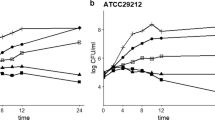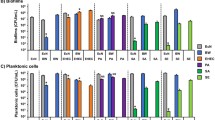Abstract
Enteropathogenic Escherichia coli (EPEC) is a bioagent that causes diarrhea through the formation of biofilm. The recalcitrant of EPEC to the current conventional antibiotic treatment has grown a big concern in a way to find effective alternative inhibitors. Aptamers have been demonstrated to show the ability to kill the pathogenic bacteria through inhibition of biofilm formation. Therefore, this study aimed to investigate antibiofilm activities of six types of aptamers against EPEC K1.1 which was isolated from patients with diarrhea. Environmental conditions such as temperatures and pH which impacted on biofilm formation of EPEC K1.1 and also biofilm inhibition of aptamer on EPEC K1.1 were performed by counting the crystal violet formation in 96-well polystyrene microplates at OD570. The motility examination combined with qPCR were applied to prove the mechanism of aptamers inhibition on biofilm by targeting essential genes that involve biofilm formation. The result showed that by applying cut off value at 0.399, aptamer SELEX 10 Colony 5 exhibited the highest biofilm inhibition against EPEC K1.1 with an absorbance value of 0.126. Further analysis showed that this aptamer also was able to reduce the motility diameter of EPEC K1.1. The effect of this aptamer on EPEC K1.1 motility was confirmed by qPCR where the mRNA level of motB, csgA and lsrA gene reduced significantly compared to the untreated group. Aptamer SELEX 10 Colony 5 was able to inhibit biofilm formation through interfering the motility ability of EPEC K1.1 and also by reducing the mRNA level of biofilm formation-related genes. This study provides evidences that aptamer is effective and promising for both antibiofilm of EPEC K1.1 and alternative treatment of diarrhea.




Similar content being viewed by others
References
[WHO] World Health Organization (2017) Diarrhoeal disease [Online]. Available from: http://www.who.int/mediacentre/diarrhea. Accessed 8 Feb 2019
[Riskesdas] Riset Kesehatan Dasar (2018) Hasil utama riskesdas 2018 Kementerian Kesehatan {Online}. Available from https://www.depkes.go.id. Accessed 8 Feb 2019
Kotloff KL, Nataro JP, Blackwelder WC et al (2013) Burden and aetiology of diarrhoeal disease in infants and young children in developing countries (the Global Enteric Multicenter Study, GEMS): a prospective, case-control study. Lancet. https://doi.org/10.1016/S0140-6736(13)60844-2
Budiarti S (1997) Pelekatan pada sel HEp-2 dan keragaman serotipe O Eschericia coli enteropatogenik isolat Indonesia. Berk Ilmu Kedokt 29:105–109
Kaper JB, Nataro JP, Mobley HLT (2004) Pathogenic Escherichia coli. Nat Rev Microbiol 2:123–140. https://doi.org/10.1038/nrmicro818
Budiarti S, Mubarik NR (2007) Extracellular protease activity of enteropathogenic Escherichia coli on mucin substrate. HAYATI J Biosci 14:36–38. https://doi.org/10.4308/hjb.14.1.36
Sicard JF, Vogeleer P, Le Bihan G et al (2018) N-acetyl-glucosamine influences the biofilm formation of Escherichia coli. Gut Pathog 10:1–10. https://doi.org/10.1186/s13099-018-0252-y
Rodrigues RS, da Silva Lima NC, Taborda RL et al (2019) Antibiotic resistance and biofilm formation in children with Enteropathogenic Escherichia coli (EPEC) in Brazilian Amazon. J Infect Dev Ctries 13:698–705. https://doi.org/10.3855/jidc.10674
Jacques M, Aragon V, Tremblay YDN (2010) Biofilm formation in bacterial pathogens of veterinary importance. Anim Health Res Rev 11:97–121. https://doi.org/10.1017/S1466252310000149
Lee JH, Kim YG, Cho HS et al (2014) Coumarins reduce biofilm formation and the virulence of Escherichia coli O157:H7. Phytomedicine. https://doi.org/10.1016/j.phymed.2014.04.008
Potera C (2010) Biofilm dispersing agent rejuvenates older antibiotics. Environ Health Perspect 118:A288
Jamal M, Tasneem U, Hussain T, Andleeb S (2015) Historical background of biofilm. Res Rev J Microbiol Biotechnol 4:1–14
Minami M, Takase H, Nakamura M, Makino T (2019) Methanol extract of Lonicera caerulea var. emphyllocalyx fruit has anti-motility and anti-biofilm activity against enteropathogenic Escherichia coli. Drug Discov Ther 13:335–342. https://doi.org/10.5582/ddt.2019.01087
Camesi ABR, Lukito A, Waturangi DE, Kwan HJ (2016) Screening of antibiofilm activity from marine bacteria against pathogenic bacteria. Microbiol Indones 10:87–94. https://doi.org/10.5454/mi.10.3.2
Witsø IL, Rukke HV, Benneche T, Scheie AA (2016) Thiophenone attenuates enteropathogenic Escherichia coli O103:H2 virulence by interfering with AI-2 signaling. PLoS ONE 11:1–16. https://doi.org/10.1371/journal.pone.0157334
de Oliveira MM, Brugnera DF, do Nascimento JA et al (2012) Cinnamon essential oil and cinnamaldehyde in the control of bacterial biofilms formed on stainless steel surfaces. Eur Food Res Technol 234:821–832. https://doi.org/10.1007/s00217-012-1694-y
Saraswat M, Musante L, Ravidá A et al (2013) Preparative purification of recombinant proteins: current status and future trends. Biomed Res Int. https://doi.org/10.1155/2013/312709
Tuerk C, Gold L (1990) Systematic evolution of ligands by exponential enrichment: RNA ligands to bacteriophage T4 DNA polymerase. Science 249:505–510. https://doi.org/10.1126/science.2200121
Sekhon SS, Lee SH, Lee KA et al (2017) Defining the copper binding aptamotif and aptamer integrated recovery platform (AIRP). Nanoscale. https://doi.org/10.1039/c6nr09408b
Reuss AJ, Vogel M, Weigand JE et al (2014) Tetracycline determines the conformation of its aptamer at physiological magnesium concentrations. Biophys J 107:2962–2971. https://doi.org/10.1016/j.bpj.2014.11.001
Tseng YT, Wang CH, Chang CP, Bin LG (2016) Integrated microfluidic system for rapid detection of influenza H1N1 virus using a sandwich-based aptamer assay. Biosens Bioelectron 82:105–111. https://doi.org/10.1016/j.bios.2016.03.073
Ren N, Atyah M, Chen W-Y, Zhou C-H (2017) The various aspects of genetic and epigenetic toxicology: testing methods and clinical applications. J Transl Med 15:110. https://doi.org/10.1186/s12967-017-1218-4
Amraee M, Oloomi M, Yavari A, Bouzari S (2017) DNA aptamer identification and characterization for E. coli O157 detection using cell based SELEX method. Anal Biochem 536:36–44. https://doi.org/10.1016/j.ab.2017.08.005
Kaur H, Bruno JG, Kumar A, Sharma TK (2018) Aptamers in the therapeutics and diagnostics pipelines. Theranostics 8:4016–4032. https://doi.org/10.7150/thno.25958
Zhang W, Liu QX, Guo ZH, Lin JS (2018) Practical application of aptamer-based biosensors in detection of low molecular weight pollutants in water sources. Molecules 23:12–16. https://doi.org/10.3390/molecules23020344
Shieh YA, Yang SJ, Wei MF, Shieh MJ (2010) Aptamer-based tumor-targeted drug delivery for photodynamic therapy. ACS Nano 4:1433–1442. https://doi.org/10.1021/nn901374b
Sun H, Zhu X, Lu PY et al (2014) Oligonucleotide aptamers: new tools for targeted cancer therapy. Mol Ther - Nucleic Acids. https://doi.org/10.1038/mtna.2014.32
Ning Y, Cheng L, Ling M et al (2015) Efficient suppression of biofilm formation by a nucleic acid aptamer. Pathog Dis 73:1–8. https://doi.org/10.1093/femspd/ftv034
Wang S, Mao B, Wu M et al (2017) Influence of aptamer-targeted antibiofilm agents for treatment of Pseudomonas aeruginosa biofilms. Antonie Van Leeuwenhoek. https://doi.org/10.1007/s10482-017-0941-4
Amilia N, Aprilian T, Mustopa AZ, Budiarto BR, Saepudin E (2019) Bandung International Conference on Food and Health (BICFH 2019), September 26-28th 2019, Bandung Institute of Technology, Bandung, West Java, Indonesia
Ribeiro KVG, Ribeiro C, Dias RS et al (2018) Bacteriophage isolated from sewage eliminates and prevents the establishment of Escherichia coli biofilm. Adv Pharm Bull 8:85–95. https://doi.org/10.15171/apb.2018.011
O’Toole GA, Kolter R (1998) Initiation of biofilm formation in Pseudomonas fluorescens WCS365 proceeds via multiple, convergent signalling pathways: a genetic analysis. Mol Microbiol 28:449–461. https://doi.org/10.1046/j.1365-2958.1998.00797.x
Mladenović KG, Muruzović M, Žugić-Petrović TD, Čomić LR (2018) The influence of environmental factors on the planktonic growth and biofilm formation of Escherichia coli. Kragujev J Sci 40:205–216. https://doi.org/10.5937/kgjsci1840205m
Stepanović S, Ćirković I, Ranin L, Švabić-Vlahović M (2004) Biofilm formation by Salmonella spp. and Listeria monocytogenes on plastic surface. Lett Appl Microbiol 38:428–432. https://doi.org/10.1111/j.1472-765X.2004.01513.x
Ling H, Kang A, Tan MH et al (2010) The absence of the luxS gene increases swimming motility and flagella synthesis in Escherichia coli K12. Biochem Biophys Res Commun 401:521–526. https://doi.org/10.1016/j.bbrc.2010.09.080
Lee JH, Park JH, Kim JA et al (2011) Low concentrations of honey reduce biofilm formation, quorum sensing, and virulence in Escherichia coli O157:H7. Biofouling 27:1095–1104. https://doi.org/10.1080/08927014.2011.633704
Mustopa AZ, Umami RN, Putri PH (2015) Identification of bioactive compound from microalga BTM 11 as hepatitis C virus RNA helicase inhibitor. J Biol Indones. https://doi.org/10.14203/jbi.v11i2.2198
Özalp VC, Bilecen K, Kavruk M, Avni Öktem H (2013) Antimicrobial aptamers for detection and inhibition of microbial pathogen growth. Future Microbiol 8:387–401. https://doi.org/10.2217/fmb.12.149
Mathlouthi A, Pennacchietti E, De Biase D (2018) Effect of temperature, pH and plasmids on in vitro biofilm formation in Escherichia coli. Acta Nat 10:129–132. https://doi.org/10.32607/20758251-2018-10-4-129-132
Bavrac AT, Donmez SI (2018) Selection of DNA aptamers to Streptococcus pneumonia and fabrication of graphene oxide based fluorescent assay. Anal Biochem 556:91–98. https://doi.org/10.1016/j.ab.2018.06.024
Wood TK, Barrios AFG, Herzberg M, Lee JT (2006) Motiliy influences biofilm architecture in Escherichia coli. Appl Microbiol Biotechnol 72:361–367. https://doi.org/10.1007/s00253-005-0263-8
Pratt LA, Kolter R (1998) Genetic analysis of Escherichia coli biofilm formation: roles of flagella, motility, chemotaxis and type I pili. Mol Microbiol 30:285–293. https://doi.org/10.1046/j.1365-2958.1998.01061.x
Barnhart MM, Chapman MR (2010) Curli biogenesis and function. Annu Rev Microbiol 60:131–147. https://doi.org/10.1146/annurev.micro.60.080805.142106.Curli
Girón JA, Torres AG, Freer E, Kaper JB (2002) The flagella of enteropathogenic Escherichia coli mediate adherence to epithelial cells. Mol Microbiol 44:361–379. https://doi.org/10.1046/j.1365-2958.2002.02899.x
Le TT, Chumphukam O, Cass AEG (2014) Determination of minimal sequence for binding an aptamer. A comparison of truncation and hybridization inhibition methods. RSC Adv 4:47227–47233. https://doi.org/10.1039/C4RA08243E
Kolovskaya OS, Savitskaya AG, Zamay TN et al (2013) Development of bacteriostatic DNA aptamers for Salmonella. J Med Chem 56:1564–1572. https://doi.org/10.1021/jm301856j
Baig IA, Moon JY, Lee SC et al (2015) Development of ssDNA aptamers as potent inhibitors of Mycobacterium tuberculosis acetohydroxyacid synthase. Biochimica et Biophysica Acta – Prot Proteom 1854:1338–1350. https://doi.org/10.1016/j.bbapap.2015.05.003
Shum KT, Lui ELH, Wong SCK et al (2011) Aptamer-mediated inhibition of Mycobacterium tuberculosis polyphosphate kinase 2. Biochemistry 50:3261–3271. https://doi.org/10.1021/bi2001455
Marton S, Cleto F, Krieger MA, Cardoso J (2016) Isolation of an aptamer that binds specifically to E. coli. PLoS O 11:e0153637. https://doi.org/10.1371/journal.pone.0153637
Zhao YW, Wang HX, Jia GC, Li Z (2018) Application of aptamer-based biosensor for rapid detection of pathogenic Escherichia coli. Sensors 18:2518. https://doi.org/10.3390/s18082518
Acknowledgements
The authors would like to thank to Nurlaili Ekawati from Research Center for Biotechnology, Indonesian Institute of Science for her assistance in manuscript preparation.
Funding
This study was fully funded and supported by Research Center for Biotechnology, Indonesian Institute of Science by Prioritas Nasional (PN) Obat 2018–2019 scheme. And also funded by Lembaga Ilmu Pengetahuan Indonesia.
Author information
Authors and Affiliations
Corresponding author
Ethics declarations
Conflict of interest
The authors declare that they have no conflict of interest.
Research involving human and animal participants
This article does not contain any studies with human or animal subjects performed by any of the authors.
Additional information
Publisher's Note
Springer Nature remains neutral with regard to jurisdictional claims in published maps and institutional affiliations.
Rights and permissions
About this article
Cite this article
Oroh, S.B., Mustopa, A.Z., Budiarti, S. et al. Inhibition of enteropathogenic Escherichia coli biofilm formation by DNA aptamer. Mol Biol Rep 47, 7567–7573 (2020). https://doi.org/10.1007/s11033-020-05822-8
Received:
Accepted:
Published:
Issue Date:
DOI: https://doi.org/10.1007/s11033-020-05822-8




